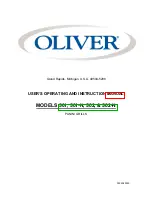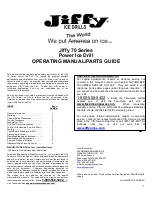
8 - English
OPERATION
To remove bits,
lock the switch trigger and open the
chuck jaws.
The bit provided with the drill can be placed in the storage
area, located on the base of the drill.
LED LIGHT
See Figure 8, page 11.
The LED light, located on the front of the tool base,
illuminates when the switch trigger is depressed.
When the tool is not in use, the time-out feature will cause
the light to start fading and then shut off.
The LED light illuminates only when there is a charged battery
pack in the tool.
TWO-SPEED GEAR TRAIN
See Figure 9, page 11.
Select
low speed
(1)
for applications requiring higher
power and torque, such as driving screws and drilling in
metal.
Select high speed
(2)
for fast drilling or driving applications,
for drilling in wood or masonry, and for hammer drilling.
NOTICE:
Never change speeds while the tool is running.
Failure to obey this caution could result in serious
damage to the drill.
NOTE:
If you have difficulty changing from one speed range
to the other, turn the chuck by hand until the gears engage.
ADJUSTING TORQUE
See Figure 10, page 11.
When using the hammer drill for various driving applications,
beginning with a lower torque setting helps prevent the pos-
sibility of damaging screw heads, threads, workpiece, etc.
In general, torque intensity should correspond to the screw
diameter. If the torque is too high or the screws too small, the
screws may be damaged or broken. The torque is adjusted
by rotating the torque adjustment ring.
The torque is greater when the torque adjustment ring is
set on a higher setting. The torque is less when the torque
adjustment ring is set on a lower setting.
Rotate the adjustment ring to the proper torque setting for
the type of material and size of screw you are using.
• 1 - 4
For driving small screws
• 5 - 8
For driving screws into soft material
• 9 - 12
For driving screws into soft and hard materi-
als
• 13 - 16 driving screws into hard wood
• 17 - 22 For driving large screws
•
For heavy drilling
•
For drilling into masonry and concrete.
DRILLING/DRIVING SCREWS
See Figure 11, page 11.
WARNING:
Always use the auxiliary handle when using this
tool to help resist torque reactions. Binding or
stalling of this product could lead to serious
personal injury.
Install the auxiliary handle.
Check the direction of rotation selector for the correct
setting (forward or reverse).
Select low
speed
(1)
or high
speed
(2)
, depending on
your application. Refer to
Two-Speed Gear Train
and
Adjusting Torque
.
Secure the workpiece in a vise or with clamps to keep it
from turning as the bit rotates.
Hold the drill firmly and place the bit at the point to be
drilled, or where the screw is to be driven.
WARNING:
Do not drive a screw where there is likely to be
hidden wiring behind the surface. Contact with a
“live” wire will make exposed metal parts of the tool
“live” and possibly shock the operator. If you must
drive a screw where hidden wire may be present,
always hold tool by insulated gripping surfaces
(handle) when performing the operation to prevent
a shock to the operator.
Depress the switch trigger to start the drill.
Move the bit into the workpiece, applying only enough
pressure to keep the bit cutting or driving the screw. Do
not force the drill or apply side pressure to elongate a
hole. Let the tool do the work.
WARNING:
When drilling, be prepared for binding at bit
breakthrough. When these situations occur, drill
has a tendency to grab and kick opposite to the
direction of rotation and could cause loss of control
when breaking through material. If not prepared,
this loss of control can result in possible serious
injury.
When drilling hard, smooth surfaces, use a center punch
to mark the desired hole location. This will prevent the bit
from slipping off-center as the hole is started.
If the bit jams in the workpiece or if the drill stalls, stop
the tool immediately. Remove the bit from the workpiece
and determine the reason for jamming.









































